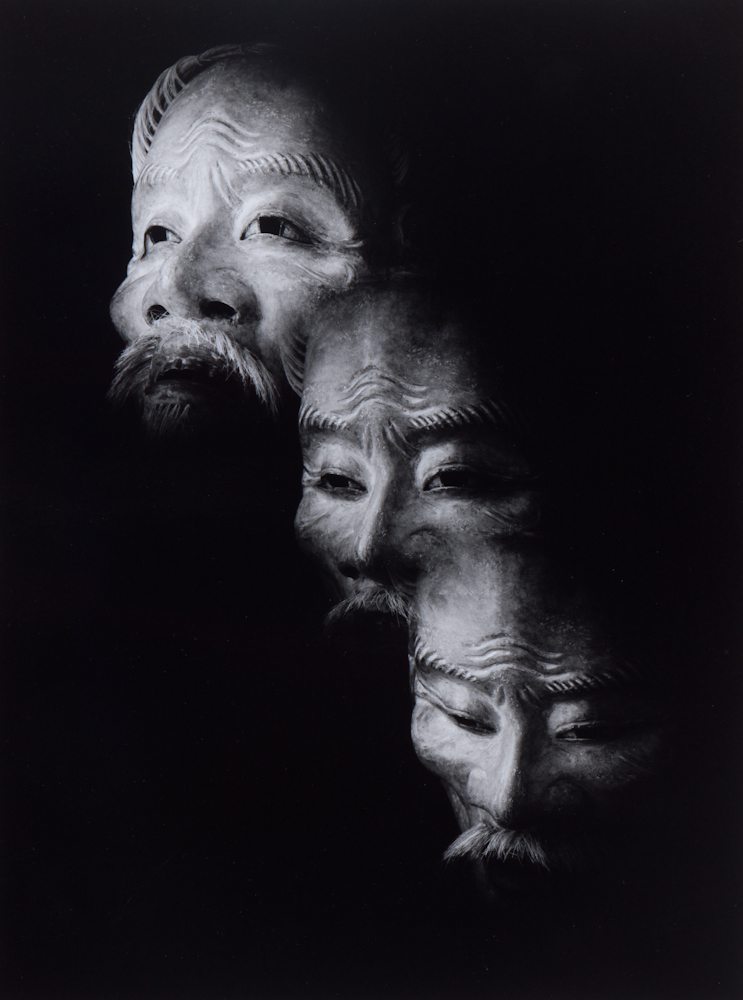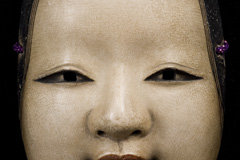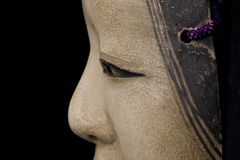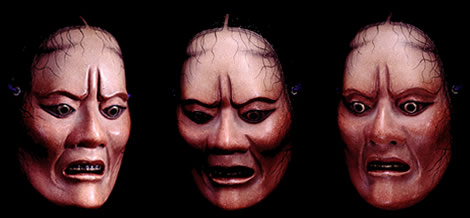Noh Mask Dimension
− Mitsue Nakamura’s Essay
“Patterns” Once Again
June 3, 2014
These days, the number of people who create Noh masks as a hobby is increasing. I am not sure of the total number nationwide, but as more people have taken up this craft, more masks have been produced. While I am pleased with this situation, I am also concerned that the overall quality of Noh masks may be deteriorating due to mass production.
In the world of the plastic arts, learners should cultivate their aesthetic sense through direct observation of the art itself, rather than through words. In short, all you need is to see the Noh mask before your eyes.
It is impossible to truly learn Noh mask making by looking at other things.
If you do not have an excellent Noh mask before you as a model, no matter how many years you spend creating masks, you will not grasp their true essence. This is a tragedy. I worry that if masks which do not embody this essence are passed down to the next generation, people may eventually lose the ability to distinguish authenticity and may also lose their sense of aesthetics.
Let me show you one example.

(Photo: Photo book “Nohmenfuushi (Noh Mask Figures)”, Mr. Teruo Amachi)
This is a photo of a “Jyo” mask. When tilted upward, it appears to look upward; when tilted downward, it appears to look downward. This may sound ordinary, but it is in fact the result of a great invention. If a Noh mask were carved exactly like a human face, it would never change its expression in this way. Try tilting your head upward and then downward without moving your eyes. No matter how you bend your head, your eyes cannot look downward.
In short, the eyes of Noh masks can move.
More precisely, when you tilt the face of a Noh mask upward, the mask appears to look slightly higher than the actual angle. Conversely, when you tilt it downward, it appears to look slightly lower. This movement mirrors the way human eyes and neck work when observing something.
“Patterns” Once Again - 2
August 23, 2014
“It is not the person who sees, but the Noh mask itself that sees.” This was what Mr. Iwao Kongo wrote in describing the beauty of the Snow Ko-omote mask.
“The audience will inevitably follow wherever the mask directs its gaze.”
This was a great invention by Noh mask craftsmen several hundred years ago.
The form of the Noh mask is something to be proud of, as it is unlike any other mask in the world.
However, not all Noh masks are created in this way. There are many exceptions, such as the Kishin category, primitive mask shapes, or masks that are not intended to convey subtle changes of expression.
In addition, great skill is required to carve delicate female masks.
This means that not all female masks display expressive changes.
This is why Mr. Kongo praised the Snow Ko-omote mask, and why many people sought its reproduction.
When I learned how to carve this mask from my master, Mr. Yasuemon Hori, I would spend entire nights turning it in different directions and staring at it in the mirror. It was a deeply moving experience.
In this sense, I honestly feel uncertain about how well this technique is understood today.
This subject was already studied in detail by Mr. Masaaki Nishida in the early Showa period. He published a precise article, explaining the elaboration of the mouth shape. Such knowledge cannot be learned from words alone, and the technique should not be kept secret. However, I suspect that most Noh craftsmen today have little recognition of this fact. I even doubt whether some craftsmen who teach Noh mask making are aware of it.
As the explanation of "shining and clouding" came to be associated with "joy and sorrow," people began to focus solely on the mask’s expression.
In short, the importance of the subtle changes in gaze has been underestimated.
-to be continued in the next essay-
“Patterns” Once Again - 3
October 23, 2014
It may seem a fine point, but it is the muscles of facial expression that create expressions in humans, while the eyes serve to see.
The U-shaped curve of Ko-omote’s lips has led to misunderstanding. A large number of Ko-omote masks have been carved with the corners of the mouth lifted.
We should not confuse this with the description: “Noh masks are asymmetrical and dynamic.” Compared to other masks around the world, Noh masks strongly tend toward refinement and symmetry. As far as I know, Mr. Yasuo Nakamura was the first to object to the group that believed masks should be carved with perfect left-right symmetry.
Noh actors are not specialists in the plastic arts, so it is natural that they judge the quality of masks through their senses. I sincerely hope they will deepen their understanding in order to preserve and pass on the true beauty of Noh masks to the next generation.
It is the duty of Noh actors to distinguish excellent masks from indiscriminate mixtures, whether old or new. At present, fewer and fewer people, aside from limited experts, have a discerning eye for masks. An overwhelming number of masks lacking eye movement have been produced and are now used in Noh. I fear that genuine Noh masks may be disappearing from our sight.
“Patterns”
November 12, 2012
“Artists create, craftsmen complete.”
This thought came to me after many years of devotion to Noh mask making.
At one point in time, a person blessed with talent created an excellent Noh mask.
Later, craftsmen with refined skills would copy that mask.
At that point, the “pattern” of the Noh mask was completed, polished and adopted by craftsmen.
In this sense, the completed “pattern,” born from copying, inevitably contains a loss of vitality.
A mask created by someone with great talent carries a free spirit. On the other hand, an imitation, however careful and detailed, loses that spirit. This also applies to increasingly perfect reproductions, I believe.
What worries me is that the completion of a style is at the same time a step toward degeneration.
“Crafting Skill - 2”
June 25, 2008
The lips have a strong curve.
In fact, they have considerable depth. Because of this, the small mouth seen from the front appears wider when the mask moves slightly.
It looks as if two mouths are integrated into one—one slightly open, the other pulled tightly back.
The eyes and mouth of the Noh mask embody movement within their form.
It is mysterious why such a deformed shape looks beautiful and graceful.
Yet Noh masks achieve this graceful beauty despite their deformation. I believe this is the most remarkable aspect of Noh masks.
“Crafting Skill”
March 10, 2008


This mask, “Manbi,” appears to look downward when viewed from the side, but from the front its eyes face forward.
This structure produces a subtle but powerful effect.
By tilting the mask slightly downward, its eyes appear to look downward.
When we look at our hands, we tilt our necks downward. Noh masks mimic this natural movement.
By tilting the mask slightly, the lower lines of the almond-shaped eyes make it appear to look downward.
On the other hand, tilting the mask slightly upward turns those lines into gentle arcs, as if smiling.
In other words, the artistry of the Manbi mask integrates both downward-looking and forward-facing eyes. This “formation that includes movement” is subtle yet the most important artistic principle in carving Noh masks.
“Nurturing”
July 15, 2007
Does the delicacy of Noh masks come from a weakness of vital force?
If we suppose that the climate of our land, blessed with four seasons, shapes our character, then surely it is the soil itself that gave rise to Noh masks.
There once was a way of life that cherished the transition of seasons, entrusted daily living to nature, and sought harmony with it.
It has been said that in Western cultures, with their monotheistic faiths, people battled and conquered wild nature; in contrast, the Japanese, who believe in many gods and goddesses, chose coexistence with nature and became nature-oriented.
“Connecting”
October 5, 2006
Noh masks have a history of 600 years. However, this does not mean it took 600 years to finalize their image. The essential form may have been completed even earlier. Their mysterious existence leads us into a maze.
I cannot help but admire when I turn the pages of a picture book and suddenly encounter a “perfected” mask, still used today, right after seeing a primitive tribal mask.
Is there any way to find the missing link that bridges these masks?
It may also be worth noting that such great developments can occur within a single artisan.
“Comparison”
April 1, 2006
Masks reveal the character of each ethnic group—not only through their outward form but also through their spirit.
Compared to foreign masks, which are often full of energy, Noh masks are delicate and embody a sense of dignity.
Noh masks do not openly display emotion, but instead condense beauty through concealment.
If modern Japanese no longer feel this subtle tension in Noh masks, we may already be like foreigners.
“Movement”
October 1, 2005
The expressions of Noh masks change.
Through light and angle, the actors’ movements, and the hidden skills of carving, their expressions shift delicately—and sometimes dramatically.
Female masks with gentle expressions reveal subtle changes when tilted slightly. It is often said that they smile when tilted up and appear sad when tilted down. But their expressions are not limited to this. In a Noh play, there is a story and an actor. The female mask may express madness or cleverness, or gaze endlessly into the distance. The secret of these changes lies in the structure of the mask itself.
Masks with strong expressions change even more dramatically with light and angle.
Hashihime transforms into:
A somber woman walking across a bridge on stage,
A jealous demon confronting her husband,
And a woman consumed by emotion, striking out at her rival in love.
Can you imagine these scenes, as Hashihime’s expression changes in three ways?







